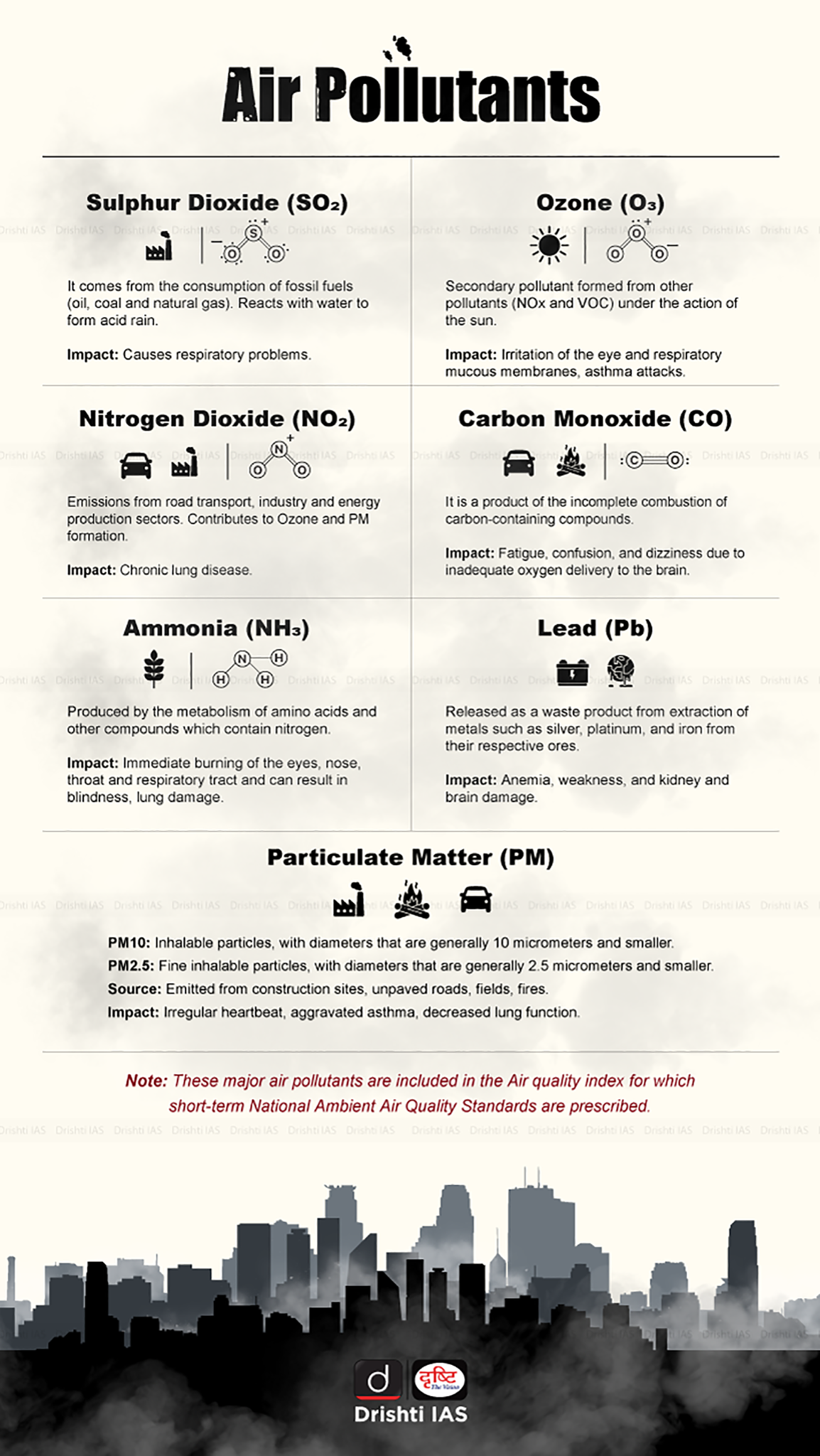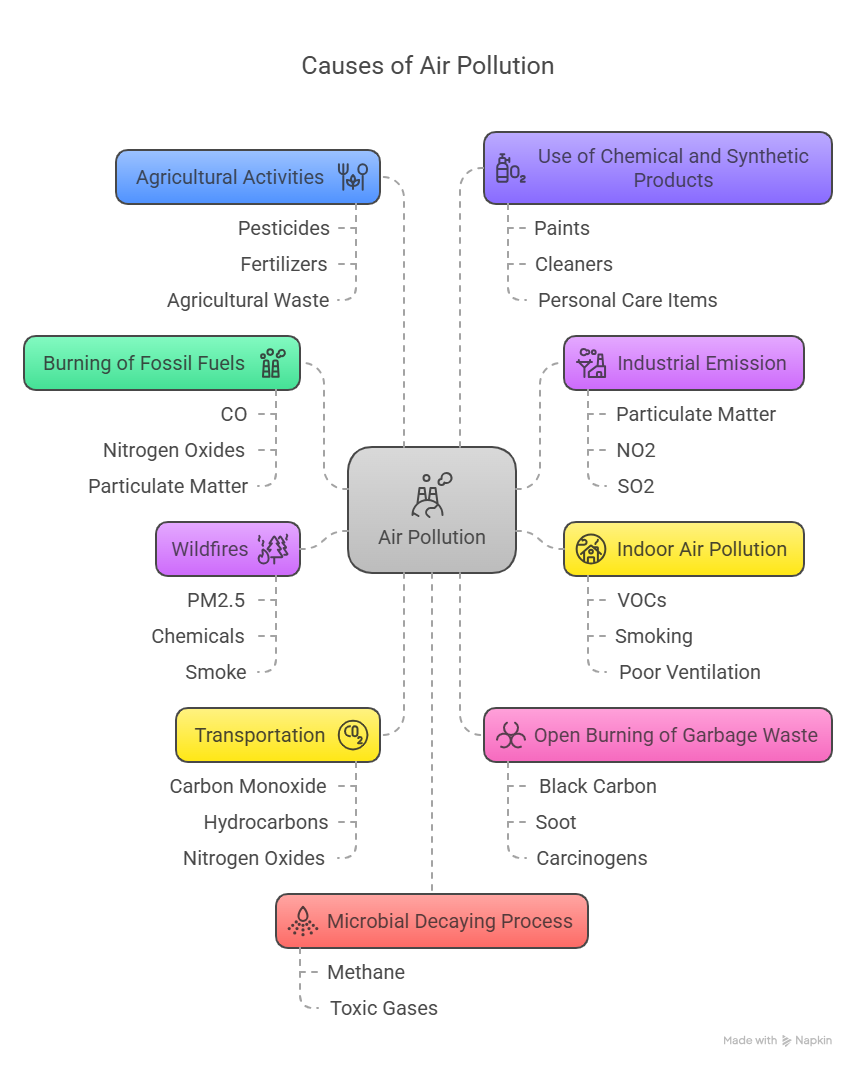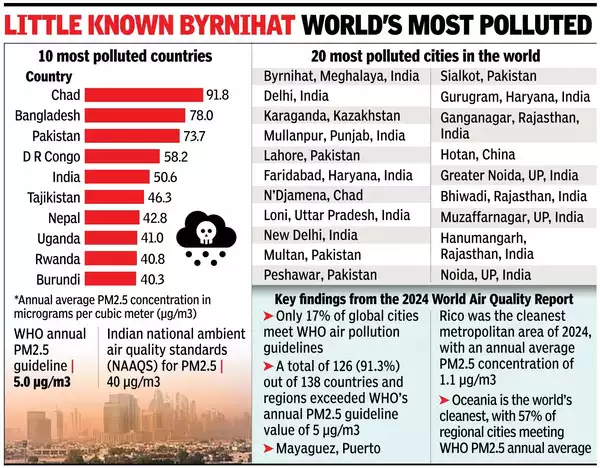Biodiversity & Environment
Data Authenticity to Fight Air Pollution
- 03 May 2025
- 16 min read
This editorial is based on "Data dressing will not help in fight against pollution," which was published in the Hindustan Times on 26/04/2025. The article highlights the issue of data manipulation related to air pollution, which may mislead both policymakers and the general public. The article also emphasizes the need for accurate and comprehensive data in the fight against pollution.
For Prelims: Continuous Ambient Air Quality Monitoring Stations, AQI, Stubble Burning, World Air Quality Report 2024, National Clean Air Programme, SAFAR Portal, Graded Response Action Plan, BS-VI Vehicles, FAME, Pradhan Mantri Ujjwala Yojana, Commission for Air Quality Management in the NCR, M.C. Mehta vs. Union of India Case, CPCB.
For Mains: Issues of Poor Air Qualities in Indian Cities and Related Challenges, Right to Clean Environment, Right to Life, Issues of Authenticity of Pollution Related Data
As India grapples with a worsening air pollution crisis, the strategic deployment of air quality monitoring infrastructure has come under scrutiny. The Delhi government’s decision to install six new Continuous Ambient Air Quality Monitoring Stations (CAAQMS) in relatively low-pollution, low-density areas like JNU and Delhi Cantonment, rather than high-pollution zones like Anand Vihar, have raised concerns about data integrity. With air pollution causing 1.67 million premature deaths annually in India (Lancet, 2020), this editorial examines the significance of transparent monitoring for India’s pollution control efforts and the challenges hindering progress.
What are the Critical Challenges in India’s Air Quality Monitoring Framework?
- Misplacement of Monitoring Infrastructure: The placement of CAAQMS in low-pollution areas, creates a skewed picture of air quality, masking the severity of pollution in hotspots like Okhla (Noida).
- This “data dressing” not only misleads policymakers but also erodes public trust, as citizens in polluted areas face unaddressed health risks.
- For instance, Anand Vihar’s AQI reached 426 in November 2023, while Delhi Cantonment recorded 172, illustrating the disparity.
- Institutional and Technical Limitations: India’s air quality monitoring network, with over 1,000 stations, is extensive (installation and operation of a CAAQMS can cost up to ₹1 crore) but faces operational challenges.
- Many CAAQMS suffer from downtime due to power outages or poor maintenance, reducing data reliability.
- The Delhi Pollution Control Committee (DPCC), tasked with overseeing monitoring, is understaffed, with only few environmental engineers for a city of over 30 million people, limiting enforcement and calibration efforts.
- Lack of Public Engagement: Public awareness of air quality data remains low, with limited efforts to educate citizens on interpreting AQI or adopting protective measures.
- Without community involvement, initiatives like NCAP struggle to gain traction. The absence of accessible, real-time data platforms further disconnects citizens from the pollution crisis, reducing pressure on authorities to act decisively.
- Geopolitical and Regional Factor: Air pollution in Delhi is exacerbated by regional factors, such as stubble burning in Punjab and Haryana, which contribute 24% of PM2.5 during winter (IIT-K, 2024).
- Inadequate monitoring in rural and peri-urban areas limits the ability to address transboundary pollution, complicating coordinated action under the Commission for Air Quality Management (CAQM).
Air Pollution
- As per the Air (Prevention and Control of Pollution) Act, 1981, "air pollution" is the presence in the atmosphere of any air pollutant, which includes any solid, liquid, or gaseous substance (including noise) in such concentration as may be or tend to be injurious to human beings, other living creatures, plants, property, or the environment.
What is the Significance of Transparent Air Quality Monitoring?
- Public Health Protection: Air pollution, particularly PM2.5, is a major public health threat, contributing to about a million and a half deaths every year from 2009 to 2019 (Lancet).
- High-pollution areas (like Anand Vihar) where AQI often exceeds 400, expose vulnerable populations—children, elderly, and low-income communities—to respiratory and cardiovascular risks.
- Strategic placement of CAAQMS in such zones provides real-time data, enabling targeted interventions like anti-smog guns or traffic controls, which can mitigate health impacts.
- Evidence-Based Policymaking: Accurate air quality data is the cornerstone of effective environmental governance. The National Clean Air Programme (NCAP), aiming to reduce particulate matter by 40% by 2026 (2019-20 as the base year), relies on reliable data to design city-specific action plans.
- Misplaced monitors, as seen in Delhi, distort AQI readings, undermining policies like the Graded Response Action Plan (GRAP) and delaying action against polluters in industrial or traffic-heavy areas.
- Economic Efficiency: Air pollution costs India 3% of its GDP annually due to healthcare expenses and lost productivity (World Bank, 2022).
- Each CAAQMS, priced at over ₹1 crore, represents a significant public investment. Deploying these in high-pollution zones maximizes their impact, ensuring resources are used to address critical areas rather than generating misleadingly optimistic data from green zones like Delhi Cantonment, where AQI is often 100 points lower than Anand Vihar.
What is the State and Impact of Air Pollution in India?
- Air Pollution in India: According to the World Air Quality Report 2024 by IQAir, India is the 5th most polluted country, with an average PM2.5 level of 50.6 µg/m³, 10 times the WHO safe limit (5 µg/m³).
- Delhi remains the most polluted capital, while Byrnihat (Assam-Meghalaya border) is the world's most polluted city.
- India dominates the global pollution list, with 6 of the top 10 and 13 of the top 20 most polluted cities.
- Globally, WHO reports that 99% of the population breathes polluted air, with low- and middle-income countries most affected.
- Impact of Air Pollution:
- Health Impact: In 2021, air pollution caused 8.1 million deaths globally, with India (2.1 million) and China (2.3 million) being the worst affected (State of Global Air Report 2024).
- Health impacts include respiratory infections, lung diseases, chronic obstructive pulmonary disease (COPD), asthma, cardiac arrest, and gastrointestinal issues.
- Economic Loss: Air pollution lowers GDP growth (3%) by reducing productivity, increasing health costs, and decreasing asset efficiency.
- Reduced Solar Efficiency: Air pollution reduces solar power efficiency by blocking radiation, while rising temperatures lower photovoltaic performance.
- By 2041-2050, India's solar panel efficiency may drop by 2.3%, causing an annual loss of at least 840 GWh of electricity.
- Environmental Degradation: Air pollution accelerates climate change by increasing greenhouse gases, degrades ecosystems through acid rain and toxin buildup, and threatens biodiversity.
- It weakens plants by excess nitrogen deposition and reduces crop yields by impairing photosynthesis due to ozone pollution.
- Health Impact: In 2021, air pollution caused 8.1 million deaths globally, with India (2.1 million) and China (2.3 million) being the worst affected (State of Global Air Report 2024).
What Measures Have Been Taken to Control Air Pollution in India?
- National Clean Air Programme (NCAP)
- System of Air Quality and Weather Forecasting and Research (SAFAR) Portal
- Graded Response Action Plan (for Delhi)
- For Reducing Vehicular Pollution:
- Pradhan Mantri Ujjwala Yojana (PMUY)
- Commission for Air Quality Management in the NCR
Note: In M.C. Mehta vs. Union of India, the Supreme Court treated the right to live in a pollution free environment as a part of fundamental right to life under Article 21 of the Constitution.
What Measures can India Adopt in Strengthening Air Quality Monitoring?
- Strategic Deployment of CAAQMS: India must prioritize installing CAAQMS and other air quality monitoring devices in high-pollution zones using GIS-based pollution mapping to identify hotspots.
- Collaborating with research institutions can ensure data-driven site selection, maximizing the impact of monitoring investments.
- Enhancing Institutional Capacity: Increasing funding and staffing for DPCC and State Pollution Control Boards (SPCBs) is critical.
- Training programs in advanced monitoring technologies and data analytics can improve operational efficiency and ensure consistent data quality.
- Promoting Data Transparency: India should revamp its public platforms and develop an independent platform for pollution related data (like Judicial Grid) for real-time, unfiltered AQI data, to prevent manipulation.
- Revamping initiatives like the Sameer app of CPCB can be scaled up to provide localized pollution alerts, empowering citizens to demand accountability.
- Fostering Regional Cooperation: Strengthening CAQM’s mandate to coordinate with neighboring states can address transboundary pollution.
- Incentives for farmers to adopt alternatives to stubble burning (like Pusa Decomposer and biomass decomposition for biogas), coupled with rural monitoring stations, can tackle regional disparities.
- Leveraging Technology and Innovation: Integrating low-cost sensor networks and satellite-based monitoring can complement CAAQMS, expanding coverage to underserved areas.
- Partnerships with startups developing AI-driven pollution forecasting tools can enhance predictive capabilities, aiding proactive interventions.
Conclusion
India’s air pollution crisis demands a robust and transparent air quality monitoring framework to protect public health, drive evidence-based policies, and optimize resources. By prioritizing high-pollution zones, enhancing institutional capacity, and engaging citizens, India can align its monitoring efforts with the goals of the National Clean Air Programme. As air pollution remains a pressing concern for UPSC aspirants, this issue underscores the need for integrated governance and technological innovation to ensure breathable air for all.
|
Drishti Mains Question: “Transparent and strategic air quality monitoring is pivotal for addressing India’s air pollution crisis." Discuss the challenges in India’s air quality monitoring framework and suggest measures to strengthen it for effective pollution control. |
UPSC Civil Services Examination Previous Year Question (PYQ)
Prelims
Q. In the cities of our country, which among the following atmospheric gases are normally considered in calculating the value of the Air Quality Index? (2016)
- Carbon dioxide
- Carbon monoxide
- Nitrogen dioxide
- Sulfur dioxide
- Methane
Select the correct answer using the code given below:
(a) 1, 2 and 3 only
(b) 2, 3 and 4 only
(c) 1, 4 and 5 only
(d) 1, 2, 3, 4 and 5
Ans: (b)
Q. Which of the following are the reasons/factors for exposure to benzene pollution? (2020)
- Automobile exhaust
- Tobacco smoke
- Wood burning
- Using varnished wooden furniture
- Using products made of polyurethane
Select the correct answer using the code given below:
(a) 1, 2 and 3 only
(b) 2 and 4 only
(c) 1, 3 and 4 only
(d) 1, 2, 3, 4 and 5
Ans: (a)
Q. In the context of solving pollution problems, what is/are the advantage/advantages of bioremediation techniques? (2017)
- It is a technique for cleaning up pollution by enhancing the same biodegradation process that occurs in nature.
- Any contaminant with heavy metals such as cadmium and lead can be readily and completely treated by bioremediation using microorganisms.
- Genetic engineering can be used to create microorganisms specifically designed for bioremediation.
Select the correct answer using the code given below:
(a) 1 only
(b) 2 and 3 only
(c) 1 and 3 only
(d) 1, 2 and 3
Ans: (c)
Mains
Q. Describe the key points of the revised Global Air Quality Guidelines (AQGs) recently released by the World Health Organisation (WHO). How are these different from its last update in 2005? What changes in India’s National Clean Air Programme are required to achieve revised standards? (2021)
Q. What are the key features of the National Clean Air Programme (NCAP) initiated by the government of India? (2020)










